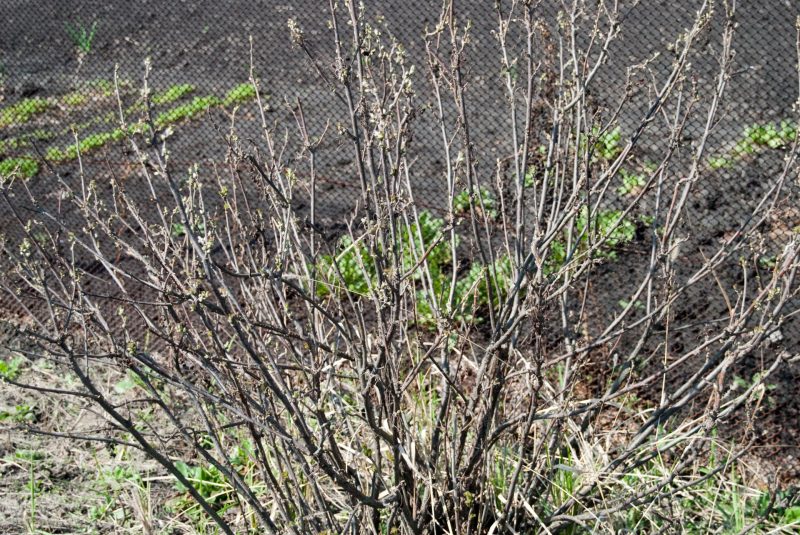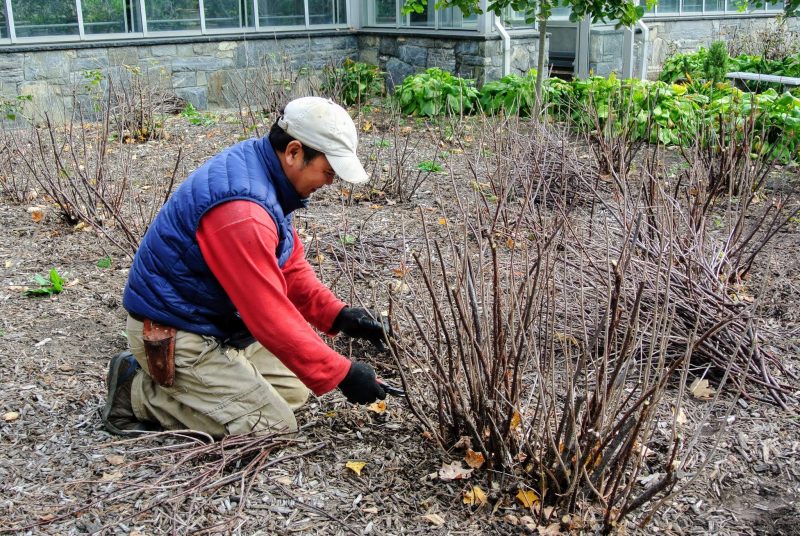Cutting currants in the fall is one of the most important steps in caring for the bush. Yield in the next year depends on the quality and correctness of the procedure. But, if you do not know the technology and timing of pruning, you can vice versa reduce the fruiting of the bush.
Material Content:
The need for pruning currant bushes
Pruning is intended not only to form a beautiful and compact bush, but also to increase productivity. Young currant is an unpretentious crop, it gives a good growth and yield. But, 3-4 years after planting, you can notice a decrease in fruiting.

The bush grows, becomes voluminous, but the volume of the harvest is significantly reduced. This is due to the fact that fruit buds are formed only on young shoots at the age of no more than 5 years. Old branches only suck out nutrients, so you need to get rid of them.
Pruning currant bushes, in addition to yield, helps to achieve these goals:
- berry size increase;
- improving the taste characteristics of the fruit by removing thickened branches and the arrival of more sunlight.
- bush formation;
- stimulating the growth of young branches;
- increased fruiting period up to 15 years;
- removal of diseased, dry or frostbitten shoots;
- accelerate the growth and development of the bush;
- stimulating the influx of nutrients to young branches.
It is in the fall that you should prune the bushes.During this period, currants are preparing for wintering, there is no sap flow, so the plant is less sensitive to this event.
Trimming is not an easy procedure, especially for beginners. You need to know all the nuances.
Important. Pruning is done so that each branch is illuminated by the sun.
Event Tools
The tool should be sharp. If earlier they had already trimmed bushes and trees, then it must be disinfected to avoid infection of the bushes with diseases.

To remove old shoots you will need:
- Secateurs. They can remove thin branches and shoots of medium thickness.
- Garden knife. With its help, all sections are smooth, but the procedure can only be carried out on thin branches.
- Hacksaw. It can cut thick shoots. It is advisable to choose a hacksaw with small teeth.
- Delimbers. This tool is needed if you need to trim in hard to reach places. He has long arms.
- Brush cutter. It is convenient to use it to remove branches of any thickness, to shape the bush.
When choosing a tool, it is important to consider not only the sharpness of the blade, but also the ease of use.
Cutting currants in autumn - a scheme for beginners
In order not to harm the bush, you must choose the right time. Pruning should be done before the onset of frost, but do not start work too soon, otherwise currants instead of preparing for wintering will begin to recover. It is likely that it will freeze.

During the autumn pruning, you must delete the following branches:
- too thin (they may not survive the winter);
- sick and dry;
- young ones who thicken the bush;
- non-fertile.
Important. Sick shoots must be removed under the root and burn them.
Pruning blackcurrant bushes
Trimming must be done annually. The technology differs depending on the age of the bush.

Important. When planting a young bush, it is necessary to cut off all branches. Leave on each 2-3 kidneys.
Blackcurrant pruning by year:
- 1st year. It is necessary to shorten the branches, leaving shoots 10-15 cm high.
- 2nd year. 4-5 young shoots are left, the remaining branches of this year are cut under the root. At this stage, a bush is formed.
- 3rd year. The branches of the 1st and 2nd year do not need to be touched. It is necessary to leave 4-5 new shoots, which do not grow inside, but outside the bush. The remaining branches of this year are deleted at the root.
- 4th year. The procedure is no different from the previous year.
For 5-6 years, anti-aging pruning is needed. During this period, the yield of old branches decreases, so they must be removed under the root, stimulating the growth of young shoots.
All sections are made with a sharp tool in the direction of the external kidney at a distance of 0.5-1 cm above.
Important. You can not cut a branch on the kidney, otherwise the shoot will die completely.
On the old bush should remain 15-20 shoots of different ages.
There is a simpler technology for beginner gardeners.
Scheme for beginners:
- The first 5 years, the bush is not pruned.
- In the 5th year, half of the shoots (old, sick, thickening the crown) are cut under the root. After pruning, it is important to feed the bush abundantly so that it builds strength.
- After a year, you need to leave up to 20 new branches, the remaining young shoots are cut.
- The following season, the remaining half of the old shoots are removed. You must leave up to 10 young. Branches older than five years must be disposed of.
Treat the cut lines with garden var.
The nuances of pruning red and white currants
Pruning red currants is not much different from black, but there is an important nuance. For the latter, it is extremely undesirable to shorten the tops of young shoots, since fruit buds form on them. Redcurrant shoots can be shortened at your discretion.The bulk of the berries is located in the lower part of the bush.
The life span of skeletal shoots of red and white currants is longer, so you need to cut old branches under the root no earlier than 7-8 years. It is impossible to shorten 2 or 3-year-old shoots, otherwise the yield will decrease.
Strongly long branches can be cut to 1/2 length, it is also worth cutting transverse processes. Powerful branches do not need to be touched.
Stages of pruning bushes for beginners
For beginners, gardeners, in order not to get confused, need to cut branches in a certain sequence.

Stages:
- Sanitary pruning. First, dry branches are cut out, then green shoots (if they have not matured, they will freeze in winter). Next, you need to remove the shoots that grow to the center of the bush, intertwine with others or lie on the ground. Lastly, diseased and deformed branches are cut out.
- Anti-aging. Old shoots are cut: older than 8 years for red and white currants, more than 5 years - for black. Annual processes are shortened by 1/3.
- Supporting. It is carried out only when the bush is thickened. If the currant is 2-3 years old, you can skip this stage.
If the bush is very thickened, because it has not been thinned for many years in a row, it is impossible to remove many shoots in one year. Currants may die. You can cut no more than 1/3 of skeletal branches.
Care after trimming
After the procedure, you need to help the bush gain strength. It is necessary to loosen the soil around and make mineral or organic fertilizers.

It is advisable to fertilize with fresh manure, superphosphate and potassium chloride. To protect against freezing, it is necessary to cover the trunk circle with sawdust or peat in a layer up to 10 cm thick. 10 kg of any mulching material is enough.
To prevent disease, you can treat the bushes with a solution of colloidal sulfur or karbofosomes. Spraying is best done in dry, calm weather.












